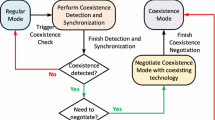Abstract
With the exponential growth in mobile data traffic taking place currently and projected into the future, mobile operators need cost effective ways to manage the load of their networks. Traditionally, this has been achieved by offloading mobile traffic onto Wi-Fi networks due to their low cost and increasingly ubiquitous deployment. Recently, LTE operating in the unlicensed spectrum has drawn significant interests from mobile operators due to the availability of the unlicensed spectrum. Using this technology, the unlicensed spectrum is directly utilized by LTE without the need to offload traffic to an alternative radio access technology such as Wi-Fi. However, the deployment of LTE networks in the unlicensed band poses significant challenges to the performance of current and future Wi-Fi networks. We discuss the LTE and Wi-Fi coexistence challenges and present analysis on performance degradation of the Wi-Fi networks at the presence of LTE.








Similar content being viewed by others
Notes
Since July 2014, 3GPP has been using License Assisted Access (LAA) as the official 3GPP term, and ETSI amended “Listen before talk” into LAA. By the time this paper was accepted, both FDD and TDD modes were introduced in TR36.889. Meanwhile, the LTE-U forum, formed by Verizon and a few other vendors in 2014, released an LTE supplemental downlink (SDL) coexistence specification, where an adaptive duty cycle based coexistence scheme was introduced, and the term “LTE-U” was used instead of “LAA” in the specification. Hence, there are now technical and business related differences between LTE-U and LAA. Various vendors and operators have developed positions in support of one or the other. However, since this paper focuses on duty cycle based LTE on unlicensed spectrum, we still use the short and conventional term LTE-U for convenience.
Although point coordination function is also defined in Wi-Fi, it is not widely implemented, and therefore not discussed in this paper.
Only standard slot configuration is considered, i.e., normal cyclic prefix with seven symbols per slot. No MIMO configuration is considered.
Note that, even if the LTE-U quiet period is long enough that the Wi-Fi user can access the channel, its transmission may be interfered by LTE-U users, seriously degrading its throughput. This is however outside the scope of this paper.
Since Wi-Fi to Wi-Fi interference below \(-82\,{\hbox {dbm}}\), LTE interference and noise can also cause transmission failure, the Wi-Fi access probability we obtain in this paper is an upper bound.
Note it is generally not true that \(p_{s}=1-p_{c}\).
References
“3GPP system to Wireless Local Area Network (WLAN) interworking; System description,” 3GPP TS 23.234 v6.9.0 (2006-06).
“U-LTE: Unlicensed spectrum utilization of LTE,” Huawei Whitepaper.
“Extending the benefits of LTE-A to unlicensed spectrum,” Qualcomm Whitepaper , April 2014.
A. M. Cavalcante and et al., “Performance evaluation of LTE and Wi-Fi coexistence in unlicensed bands,” in Vehicular Technology Conference (VTC Spring), 2013 IEEE 77th, pp. 1–6, IEEE, 2013.
T. Nihtila, V. Tykhomyrov, O. Alanen, M. Uusitalo, A. Sorri, M. Moisio, S. Iraji, R. Ratasuk, and N. Mangalvedhe, “System performance of LTE and IEEE 802.11 coexisting on a shared frequency band,” in Wireless Communications and Networking Conference (WCNC), 2013 IEEE, pp. 1038–1043, April 2013.
“Technical Specification Group Radio Access Network; Study on Licensed-Assisted Access to Unlicensed Spectrum; (Release 13),” 3GPP TR 36.889.0.4.0.
H. Alnuweiri, Y. Fallah, P. Nasiopoulos, and S. Khan, “OFDMA-Based Medium Access Control for Next-Generation WLANs,” EURASIP Journal on Wireless Communications and Networking 2009(1), p. 512865, 2009.
G. Bianchi, “Performance analysis of the IEEE 802.11 distributed coordination function,” Selected Areas in Communications, IEEE Journal on 18(3), pp. 535–547, 2000.
H. Zhai, Y. Kwon, and Y. Fang, “Performance analysis of IEEE 802.11 MAC protocols in wireless LANs,” Wireless communications and mobile computing 4(8), pp. 917–931, 2004.
A. Banchs, P. Serrano, and A. Azcorra, “End-to-end delay analysis and admission control in 802.11 DCF WLANs,” Computer Communications 29(7), pp. 842–854, 2006.
A. Papoulis and S. U. Pillai, Probability, random variables, and stochastic processes, Tata McGraw-Hill Education, 2002.
“Broadband Radio Access Networks (BRAN); GHz high performance RLAN; Harmonized EN covering the essential requirements of article 3.2 of the R&TTE Directive,” ETSI EN 301 893 V1.7.1 (2012-06).
Author information
Authors and Affiliations
Corresponding author
Rights and permissions
About this article
Cite this article
Babaei, A., Andreoli-Fang, J., Pang, Y. et al. On the Impact of LTE-U on Wi-Fi Performance. Int J Wireless Inf Networks 22, 336–344 (2015). https://doi.org/10.1007/s10776-015-0288-6
Received:
Accepted:
Published:
Issue Date:
DOI: https://doi.org/10.1007/s10776-015-0288-6




